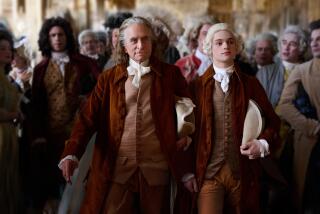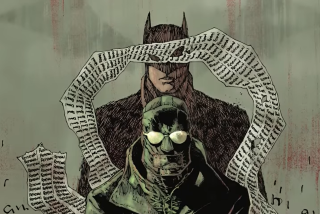Being There
- Share via
On the day of the 1929 stock market crash, a young man climbs to the roof of a New York skyscraper. Unlike the ruined investors soon to jump from such heights, he exudes optimism and freedom. A gust of wind snatches off his yellow fedora and swoops it through a window of a neighboring building. Tracking it down, he finds it in an empty office, along with a photo of a woman whose face--seemingly a composite of many faces--will haunt him the rest of his life.
Nicholas Christopher’s fourth novel opens with these images, as visual as frames in a comic book. We can see the young man silhouetted against the sky, the plunging view to the street, the yellow hat on its unerring course, the enigmatic picture. The novel’s characters are sketched quickly and, as it were, with a broad brush; the action is compressed and, as in comics, freighted with fatality and symbolism. Those for whom the 1930s and ‘40s are memories as well as history will know what kind of comics inspired Christopher. “Terry and the Pirates” and “The Phantom” are examples: quasi-realistic action mixed with romance and trademark elements, such as the Phantom’s skin-tight suit, that alerted us that the protagonist, however much he resembled an ordinary human being, was, in fact, something quite different: a hero.
On the surface, Franklin Flyer (named for a passenger train whose crash he survived at birth) is an exemplary young American of his time: bright, talented, handy with his fists, an inventor and a patriot. It’s the trademarks that reveal him to be more and less than that--the name, the yellow fedora, the faithful cat (survivor of an Antarctic shipwreck) who accompanies Flyer through all his adventures and whose night vision prompts him to develop infrared technology for the military in World War II.
Christopher (“A Trip to the Stars”) allots one chapter of this novel to each year from 1929 through 1942. Each chapter, like an individual comic book in a series, is a self-contained episode but is linked to the others.
Comics require fine craftsmanship, and the episodes (in Argentina, in Ku Klux Klan territory, in Mussolini’s Italy, in Vichy France) are admirably concise. Through his choice of method, Christopher lets us tap into moral certainties about a bygone age (Fascists are bad, isolationists are fools) and, as in “Ragtime” and “Forrest Gump,” allows his fictional characters to mingle with historical figures, from actress Rita Hayworth to OSS chief “Wild Bill” Donovan.
As a hero, not just a person, Flyer escapes one tight spot after another as he battles Nazis and their sympathizers for control of the world’s supply of zilium, a rare but indestructible metal that the Axis seeks to make its forces bulletproof. His career advances in near-magical leaps. With profits from his first patented invention, a machine that jiggles a paint can to mix the paint, he buys a firm that publishes adventure comics, of course, with titles such as “River Detective” and “Diamond Courier.”
Part of the charm of “Franklin Flyer” is its nostalgia for the era of the individual tinkerer, before the war made technology the domain of vast organizations. Flyer goes to the library, reads up on “vacuum tubes, cathode rays, the conductivity of metals and the evolution of the electron tube filament,” and voila! He makes a key contribution to David Sarnoff’s pioneering work on television.
Only Flyer’s love life is dogged by misfortune. Searching for the woman in the picture, he has relationships with Narcissa, a self-destructive jazz singer; Pamela, a beauty disfigured by jealousy; Persephone, an editor at his firm who has an unsettling knowledge of ancient Egyptian lore; and Agnes, an OSS agent who leads him into his most dangerous adventure. Along the way, he discovers that he has a daughter, Leda--another mythological name--whose fatherless childhood has mirrored his own.
Indeed, Christopher gives Flyer a full complement of motivations and vulnerabilities, as if he were a person and this were a realistic novel. We tend to overlook this because the action is so fast and because we’re so sure, on account of the trademarks, that he’s a hero.
Like zilium--which is imaginary and, as ultimate weapons go, no match for the atomic horrors the real world of the ‘40s was brewing--Flyer can’t quite escape the world of the comics, even when, in the novel’s mystical conclusion, Christopher wants him to.
More to Read
Sign up for our Book Club newsletter
Get the latest news, events and more from the Los Angeles Times Book Club, and help us get L.A. reading and talking.
You may occasionally receive promotional content from the Los Angeles Times.










